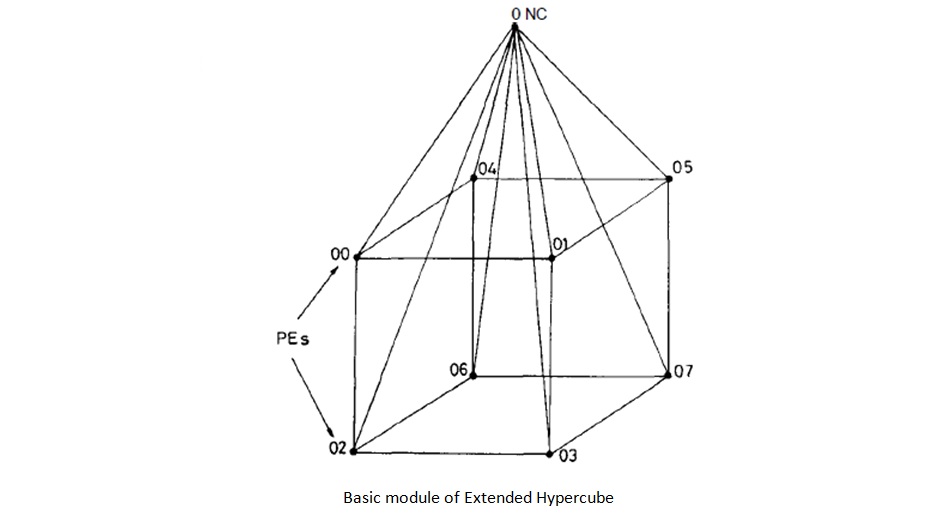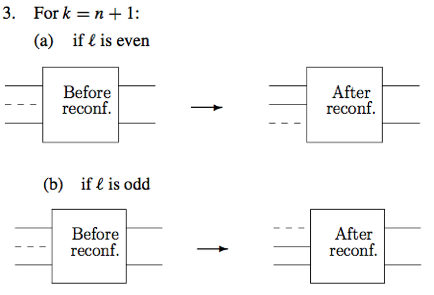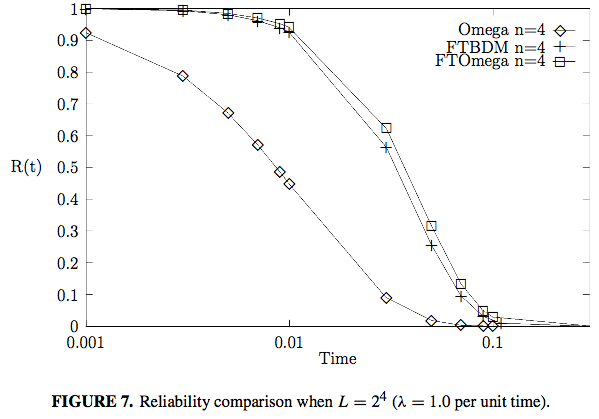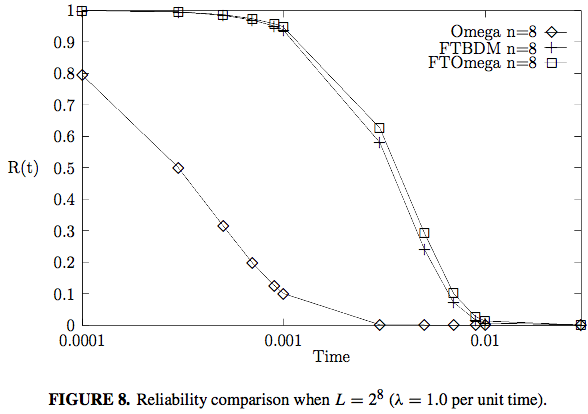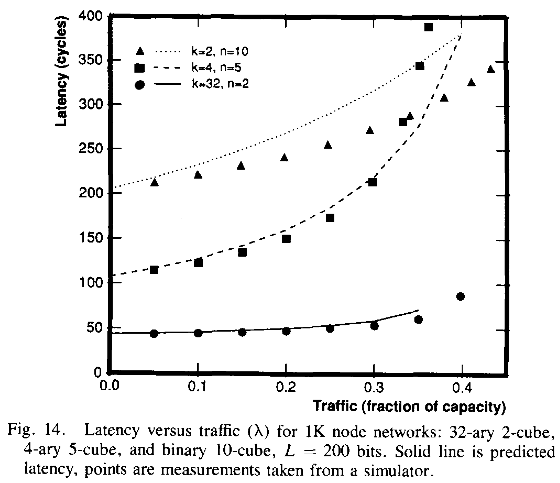User:Mdcotter: Difference between revisions
| (75 intermediate revisions by 2 users not shown) | |||
| Line 17: | Line 17: | ||
==Metrics Interconnection Networks== | ==Metrics Interconnection Networks== | ||
===Network Connectivity=== | |||
Network nodes and communication links sometimes fail and must be removed from service for repair. When components do fail the network should continue to function with reduced capacity. | |||
Network connectivity measures the resiliency of a network and its ability to continue operation despite disabled components i.e. connectivity is the minimum number of nodes or links that must fail to partition the network into two or more disjoint networks | |||
The larger the connectivity for a network the better the network is able to cope with failures. | |||
== | ===Network Diameter=== | ||
The diameter of a network is the maximum internode distance i.e. it is the maximum number of links that must be traversed to send a message to any node along a shortest path. | |||
The lower the diameter of a network the shorter the time to send a message from one node to the node farthest away from it. | |||
== | ===Narrowness=== | ||
This is a measure of congestion in a network and is calculated as follows: | |||
Partition the network into two groups of processors A and B where the number of processors in each group is Na and Nb and assume Nb < = Na. Now count the number of interconnections between A and B call this I. Find the maximum value of Nb / I for all partitionings of the network. This is the narrowness of the network. | |||
The idea is that if the narrowness is high ( Nb > I) then if the group B processors want to send messages to group A congestion in the network will be high ( since there are fewer links than processors ) | |||
== | ===Network Expansion Increments=== | ||
A network should be expandable i.e. it should be possible to create larger and more powerful multicomputer systems by simply adding more nodes to the network. | |||
For reasons of cost it is better to have the option of small increments since this allows you to upgrade your network to the size you require ( i.e. flexibility ) within a particular budget. | |||
E.g. an 8 node linear array can be expanded in increments of 1 node but a 3 dimensional hypercube can be expanded only by adding another 3D hypercube. (i.e. 8 nodes) | |||
=Hypercube= | |||
Hypercube networks consist of N = 2n nodes arranged in a k dimensional hypercube. The nodes are numbered 0 , 1, ....2n -1 and two nodes are connected if their binary labels differ by exactly one bit. | |||
The attractiveness of the hypercube topology is its small diameter, which is the maximum number of links (or hops) a message has to travel to reach its final destination between any two nodes. For a hypercube network the diameter is identical to the degree of a node n = log2N. There are 2n nodes contained in the hypercube; each is uniquely represented by a binary sequence bn-1bn-2...b0 of length n. Two nodes in the hypercube are adjacent if and only if they differ at exactly one bit position. This property greatly facilitates the routing of messages through the network.<ref name="hyp-ext">Liu Youyao; Han Jungang; Du Huimin; "A Hypercube-based Scalable Interconnection Network for Massively Parallel Computing" JOURNAL OF COMPUTERS, VOL. 3, NO. 10, OCTOBER 2008[http://www.academypublisher.com/jcp/vol03/no10/jcp0310058065.pdf]</ref> | |||
[[File:1d-cube.jpg|center|Fig 1.|Basic Hypercube Structures ]] | |||
In addition, the regular and symmetric nature of the network provides fault tolerance. Most Important parameters of an interconnection network of a multicomputer system are its scalability and modularity. Scalable networks have the property that the size of the system (e.g., the number of nodes) can be increased with minor or no change in the existing configuration. Also, the increase in system size is expected to result in an increase in performance to the extent of the increase in size. a major drawback of the hypercube network is its lack of scalability, which limits its use in building large size systems out of small size systems with little changes in the configuration. As the dimension of the hypercube is increased by one, one more link needs to be added to every node in the network. Therefore, it becomes more difficult to design and fabricate the nodes of the hypercube because of the large fan-out. | |||
[[File:4d-hyper.jpg]] | |||
=Twisted Cubes= | |||
Twisted cubes are variants of hypercubes. The n-dimensional twisted cube has 2n nodes and n2n-1 edges. It possesses some desirable features for interconnection networks . Its diameter, wide diameter, and faulty diameter are about half of those of the n-dimensional hypercube. A complete binary tree can be embedded into it. The five-dimensional twisted cube TQ5, where the end nodes of a missing edge are marked with arrows labeled with the same letter is shown below | |||
[[File:Twsit-1.jpg]] | |||
=Extended Hypercube= | |||
The hypercube networks are not truly expandable because we have to change the hardware configuration of all the nodes whenever the number of nodes grows exponentially, as the nodes have to be provided with additional ports. an incompletely populated hypercube lacks some of the properties which make the hypercube attractive in the first place <ref name="ext-hypercube">J.Mohan Kumar; L.M.Patnaik; "Extended Hypercube: A Hierarchical Interconnection Network of Hypercubes" IEEE TRANSACTIONS ON PARALLEL AND DISTRIBUTED SYSTEMS, VOL. 3, NO. 1, JANUARY 1992 [http://eprints.iisc.ernet.in/6842/1/12.pdf]</ref>. Complicated routing algorithms are necessary for the incomplete hypercube. Extended Hypercube(EH) retains the attractive features of the hypercube topology to a large extent. The EH is built using basic modules consisting of a k-cube of processor elements (PE’s) and a Network Controller (NC) as shown in the figure below. The NC is used as a communication processor to handle intermodule communication; 2k such basic modules can be interconnected via 2k NC’s, forming a k-cube among the NC’s. The EH is essentially a truly expansive, recursive structure with a constant predefined building block. The number of I/O ports for each PE (and NC) is fixed and is independent of the size of the network. The EH structure is found to be most suited for implementing a class of highly parallel algorithms. The EH can emulate the binary hypercube in implementing a large class of algorithms with insignificant degradation in performance. The utilization factor of the EH is higher than that of the Hypercube <ref name="Otis-Hypercube">Basel A. Mahafzah; Bashira A. Jaradat; "The load balancing problem in OTIS-Hypercube interconnection networks" The Journal of Supercomputing Volume 46 Issue 3, December 2008 [http://www.springerlink.com.prox.lib.ncsu.edu/content/vux017112073p8w7/fulltext.pdf]</ref>. | |||
[[File:Ext.jpg]] | |||
=Balanced Hypercube= | |||
As the number of processors in a system increases, the probability of system failure can be expected to be quite high unless specific measures are taken to tolerate faults within the system. Therefore, a major goal in the design of such a system is fault tolerance. These systems are made fault-tolerant by providing redundant or spare processors and/or links. When an active processor (where tasks are running) fails, its tasks are dynamically transferred to spare components. The objective is to provide an efficient reconfiguration by keeping the recovery time small. It is highly desirable that the reconfiguration process is a decentralized and local one, so fault status exchange and task migration can be reduced or eliminated. | |||
The Balanced Hypercube is a variation of the Hypercube structure that can support consistently recoverable embedding. Balanced hypercubes belong to a special type of load balanced graphs [10] that can support consistently recoverable embedding. In a load balanced graph G = (V, E), with V as the node set and E as the edge set, for each node v there exists another node v’, such that v and v’ have the same adjacent nodes. Such a pair of nodes v and v’ is called a matching pair. | |||
[[File:Ext1.jpg]] | |||
In a load balanced graph, a task can be scheduled to both v and v’ in such a way that one copy is active and the other one is passive. If node v fails, we can simply shift tasks of v to v’ by activating copies of these tasks in v’. All the other tasks running on other nodes do not need to be reassigned to keep the adjacency property, i.e., two tasks that are adjacent are still adjacent after a system reconfiguration. Note that the rule of v and v’ as primary and backup are relative. We can have an active task running on node v with its backup on node v’, while having another active task running on node v’ with its backup on node v. With a sufficient number of tasks and a suitable load balancing approach, we can have a balanced use of processors in the system. | |||
[[File:Ext2.jpg]] | |||
A graph G is load balanced if and only if for every node in G there exists another node matching it, i.e., these two nodes have the same adjacent nodes. Hence they are called a matching pair. A completely connected graph with an even number of nodes is load balanced, while several other commonly used graph structures, such as meshes, trees, and hypercubes, are not. In the figures shown labeled as BHn, n is called the dimension of the balanced hypercube. | |||
=Balanced Varietal Hypercube= | |||
A n dimensional, balanced varietal hypercube consists of 2^2n nodes. Every node connects 2n nodes, which are of 2 types :a)Inner nodes b)Outer nodes through hyperlinks <ref name="ext-var">C. R. Tripathy; N. Adhikari; "ON A NEW MULTICOMPUTER INTERCONNECTION TOPOLOGY FOR MASSIVELY PARALLEL SYSTEMS" International Journal of Distributed and Parallel Systems (IJDPS) Vol.2, No.4, July 2011[http://arxiv.org/ftp/arxiv/papers/1108/1108.1462.pdf]</ref> | |||
a) Inner node: | |||
Case I: When a0 is even: | |||
(i) <(a0+1)mod 4, a1,a2..... an-1> | |||
(ii)< (a0-2)mod 4, a1,a2..... an-1> | |||
Case II: When a0 is odd: | |||
(i) <(a0-1)mod 4, a1,a2..... an-1> | |||
(ii)< (a0+2)mod 4 ,a1,a2..... an-1> | |||
b) Outer node: | |||
Case I: When a0=0,3: | |||
(i) For ‘ai’ = 0 | |||
<(a0+1) mod 4 , a1,....,(ai+1)mod 4 a2,....,an-1> | |||
<(a0-1) mod 4 , a1,....,(ai+1)mod 4 a2,....,an-1> | |||
(ii) For ‘ai’ = 3 | |||
<(a0+1) mod 4 , a1,....,(ai-1)mod 4 ,....,an-1> | |||
<(a0-1) mod 4 , a1,....,(ai-1)mod 4 ,....,an-1> | |||
Case II: when a0=1,2 and ai= 0,3: | |||
<(a0+1) mod 4 , a1,....,(ai+2)mod 4 ,....,an-1> | |||
<(a0-1) mod 4 , a1,....,(ai+2)mod 4 ,....,an-1> | |||
Case III: when a0=0,1 | |||
(i) For ai=1 | |||
<(a0+1) mod 4 , a1,....,(ai+2)mod 4 ,....,an-1> | |||
<(a0-1) mod 4 , a1,....,(ai-1)mod 4 ,....,an-1> | |||
(ii) For ai=2 | |||
<(a0+1) mod 4 , a1,....,(ai+2)mod 4 ,....,an-1> | |||
<(a0+1) mod 4 , a1,....,(ai+2)mod 4 ,....,an-1> | |||
Case IV: when a0=2,3 | |||
(i) For ai=1 | |||
<(a0+1) mod 4 , a1,....,(ai-1)mod 4 ,....,an-1> | |||
<(a0-1) mod 4 , a1,....,(ai+2)mod 4 ,....,an-1> | |||
(ii) For ai=2 | |||
<(a0+1) mod 4 , a1,....,(ai+1)mod 4 ,....,an-1> | |||
<(a0-1) mod 4 , a1,....,(ai+2)mod 4,....,an-1> | |||
[[File:Evh.jpg]] | |||
==Properties of a Balanced Varietal Hypercube== | |||
The degree of any node in the Balanced varietal hypercube of dimension n is equal to 2n. | |||
An n-dimensional Balanced varietal hypercube has n* 22n edges. | |||
The diameter of an n-dimensional Balanced varietal hypercube is | |||
i. 2n for n=1 | |||
ii. ceil(n+n/2) for n> 1. | |||
The average distance conveys the actual performance of the network better in practice. The summation of distance of all nodes from a given node over the total number of nodes determines the average distance of the network. In the Balanced varietal hypercube the average distance is given by 1/(2^2n)∑[d(0,0,0),k] | |||
Cost is an important factor as far as an interconnection network is concerned. The topology | |||
which possesses minimum cost is treated as the best candidate. Cost factor of a network is the | |||
product of degree and diameter. The cost of an n-dimensional balanced varietal hypercube is given by 2n* ceiling(n + n/2). | |||
==Routing in Balanced Varietal Hypercube== | |||
In routing process, each processor along the path considers itself as the source and forwards the message to a neighbouring node one step closer to the destination. The algorithm consists of a left to right scan of source and destination address. Let r be the right most differing bit (quarternary) position. The numbers to the right of ur is not to be considered as they lie on the same BVHr . Since the diameter of BVH1 is 2 there is atleast one vertex which is a common neighbour of ur and vr. If d is an element such that d neighbour of ur is also a neighbour of vr.Then d is choosen such that ur=vr. Then in the next step d1 is choosen such that ur-1=vr-1. This process continues until u=v. | |||
Algorithm:Procedure Route(u,v) | |||
{ | |||
r: right most differing bit position | |||
d:choice such that dur=vr | |||
route to d-neighbour else | |||
route to r-neighbour (k and v are adjacent) | |||
if (u and v are not adjacent) then | |||
d1=choice that dur-1=dvr-1 | |||
route to d1 neighbour | |||
} | |||
==Broadcast in Balanced Varietal Hypercube== | |||
Broadcasting refers to a method of transferring a message to all recipients simultaneously.The broadcast primitive finds wide application in the control of distributed systems and in parallel computing. An optimal one-to-all broadcast algorithm is presented for BVHn assuming that concurrent communication through all ports of each processor is possible. It consists of (n+1) steps as shown below. | |||
Procedure Broadcast(u,n): | |||
Step1: send message to 2n neighbours of u | |||
Step 2: one of 2n nodes sends message to its 2n-1 neighbours. Then n nodes from the rest nodes | |||
send message to their (2n-2) neighbours. | |||
Step 3: continue step 2 till all the nodes get the message. | |||
Step 4: end | |||
=Reliable Omega interconnected networks= | |||
The omega network topology supports both one-to-one routing and broadcast routing. Since every node in the system is a fixed size, the system can be easily scaled to larger systems. The omega network belongs to the multistage interconnection networks (MINs). Since the omega network is designed for larger systems, it depends heavily on reliability, therefore we will also discuss an enhanced version of the omega network <ref name="omega">Bataineh, Sameer; Qanzu'a, Ghassan.; , "Reliable Omega Interconnected Network for Large-Scale Multiprocessor Systems" The Compter Journal, 2003. vol. 46, no. 5, pp.467-475, 2003 [http://comjnl.oxfordjournals.org/content/46/5/467.abstract]</ref>. | |||
The original omega distributed-memory multiprocessor is of size... | |||
*N=L x (log2(L) + 1) | |||
** N = number of switches | |||
** L = number of levels | |||
** (log2(L) + 1) = number of stages | |||
Each link between nodes is used bidirectionally to send data. | |||
[[File:Figure_1_Omega_Design.png|400px|center]] | |||
Figure 1 above has 32 nodes with 8 levels. Each node as four links connected it to the previous and next stages. The connections go as follows. | |||
*Output link ''x'' on stage ''g'' connects to input link ''σn(x)'' on stage ''g+1'' | |||
**0 ≤ g < log2(L) | |||
**''x'' is an ''n+1'' bit number if the form ''x = {bn,bn-1,...,b1,b0}'' | |||
**''σn(x) = {bn−1,...,b2,b1,b0,bn}'' | |||
**In the Figure 1 above ''L=8, N=32, n=3, and x=0-15'' and has a four bit representation | |||
===Proposed Reliable Omega Design=== | |||
To create a more reliable design, it must ensure that the system maintains its structure after a fault. Therefore for the proposed design there are extra links between nodes and an extra stage the end to improve reliability. This way if a node faults it can be replaced. | |||
The extra links are added as such... | |||
# [[File:Proposed_Link_1.png]] where ''0 ≤ g<n−1'' and '' n = log2(L)'' | |||
#[[File:Proposed Link 2.png]] | |||
#[[File:Proposed_Link_3.png]] if ''l'' is even and ''0 < g ≤ n'' | |||
#Two links for [[File:Proposed_Link_4.png]] | |||
The added links and nodes are represented in Figure 2 below. | |||
[[File:Figure_2_Proposed_Omega.png|550px|center]] | |||
===Node Replacement Policy and Reconfiguration=== | |||
When a node fails in the system it must be reconfigured to replace it and maintain the omega topology. | |||
====Replacement==== | |||
If a spare node fails then it does not requeire replacement and can easily be bypassed. However if and active node fails, then it must be replaced by its dual node. The dual node is replaced by it dual node until a spare node replaces the original active node. | |||
The dual of a node is determined by... | |||
*''(g,l)'' has a dual node at ''(g+1, 2 ( l%L/2) + bn)'', where ''g ≤ n − 1'' | |||
*... or ''(n,l)'' has a dual node at ''(n + 1, l)'' if that is a spare node to the right in the same level | |||
====Reconfiguration==== | |||
A node path can suffer one fail then all other nodes perform the Replacement procedure. However, if another node fails then all nodes after that participate in the Reconfiguration procedure. | |||
The reconfiguration procedure is as follows... | |||
*The failed node is bypassed | |||
*The node ''(k,l)'' in the node path carries out the following steps. | |||
[[File:Reconfig_1.png|300px|border]] | |||
[[File:Reconfig_2.png|300px|border]] | |||
[[File:Reconfig_3.png|300px|border]] | |||
=== Reliability Analysis=== | |||
[[File:Reliability_Fig7.png]][[File:Reliability_Fig8.png]] | |||
Figure 7 and Figure 8 above graph the reliability [R(t)] of the Omega, Fault-tollerant Butterfly, and fault-tolerant omega topologies over time. This shows that the fault-tolerant omega demonstrates more reliability over time than the original omega design, even with added complexity. | |||
=K-Ary n-cube Interconnection networks= | |||
The purpose of this section is to demonstrate how the outdated k-ary n-cube interconnection networks were never really used for large scale multiprocessor systems.<ref name="k-ary">Dally, William J.; , Performance Analysis of k-ary n-cube | |||
Interconnection Networks" IEEE Transactions on Computers. vol. 39, no. 6, pp.775-785, June 1990 [http://ieeexplore.ieee.org/xpl/login.jsp?tp=&arnumber=53599&url=http%3A%2F%2Fieeexplore.ieee.org%2Fxpls%2Fabs_all.jsp%3Farnumber%3D53599]</ref> VLSI systems, a.k.a k-ary n-cube, are communication limited rather than processing limited. This means that is performance is dependent on the wire used to connect the system. This section will show through latency, throughput, hot-spot throughput that k-ary n-cube interconnection networks work better on lower-dimensional networks than it does on high-dimensional networks, assuming constant bisectional width. | |||
===VLSI Complexity=== | |||
Since VLSI systems are wire-limited, meaning that the speed that it can run at is dependent on the wire delay. This means that systems are required to organize there nodes logically and physically to keep the wires as short as possible. Networks that work with higher dimensions cost more dut to the fact that there are more and longer wires, compared to low-dimension networks. | |||
===Latency=== | |||
Latency is a measure of network performance, where it is the sum of the latency due to the network and the latency due to the processing node. Figure 8 below shows the average network latency vs dimension with varying nodes. Figure 8 demonstrates that low-dimensional networks provide lower latency than high-dimensional networks with a constant delay. | |||
[[File:Latency_Fig8.png]] | |||
The low-dimensional networks are able to capitalize on locality and have lower latency. However, the high-dimensional networks are do not benefit from locality and are forced to have longer message lengths. | |||
[[File:Latency_Fig9.png]] | |||
[[File:Latency_Fig10.png]] | |||
Figure 9 and 10 further demonstrate how latency increases with higher dimensional networks, using logarithmic and linear delay. With linear delay, latency is determined solely by bandwidth and physical distance, putting the higher dimensional networks at a disadvantage. | |||
===Throughput=== | |||
Throughput is another metric of network performance. Throughput is the total number of messages the network can handle per unit of time. This can best be estimated by calculating the total capacity of the given network. Low-dimensional networks's latency increase slower when the traffic is actually applied vs high-dimensional networks. The low-dimensional networks are able to handle contention better because they use fewer channels at higher bandwidth and get better throughput performance than the high-dimensional networks. | |||
[[File:Latency Fig14.png|400px]] | |||
Figure 14 above shows how latency increases as there is more traffic applied to the different k-ary n-cube systems. | |||
===Hot-Spot Throughput=== | |||
Hot spot throughput describes the situation where traffic is not uniform, instead it is concentrated in a pair of nodes that is responsible for higher traffic. Hot-spot traffic causes congestion and can hurt the throughput. As with normal throughput, low-dimensional networks have better bandwidth and thus better hot-spot throughput than the high-dimensional networks. | |||
===Conclusion=== | |||
Low-dimensional k-ary n-cube networks have lower latency, less contention, and higher hot-spot throughput than the high-dimensional networks. This demonstrates how this outdated network technique is not suitable for larger machines, cause is does not scale well. | |||
=Glossary= | |||
*'''Latency''' - network measurement of time delay | |||
*'''Throughput''' - network measurement of the total number of messages the network can handle at a time | |||
*'''Hot-Spot Throughput''' - describes the situation where traffic is not uniform and certain nodes are responsible for higher traffic. | |||
=Quiz= | |||
'''Question 1 : Two nodes in the hypercube are adjacent if and only if they differ at how many bit positions''' | |||
a) Two | |||
b) One | |||
c) Three | |||
d) Zero | |||
'''Question 2 : A n dimensional, balanced varietal hypercube consists of how many nodes?''' | |||
a) 2n | |||
b) 2n-1 | |||
c) 2^2n | |||
d) 2^2n -1 | |||
'''Question 3 :The maximum number of links that must be traversed to send a message to any node is the''' | |||
a) Network Narrowness | |||
b) Network Increments | |||
c) Network Diameter | |||
d) Network Connectivity | |||
'''Question 4 :It is difficult to design and fabricate the nodes of the hypercube because''' | |||
a) Large fan out | |||
b) Increased Heat Dissipation | |||
c) Lesser number of neighbours | |||
d) Small Diameter | |||
'''Question 5 : A good reason for choosing Balanced Hypercube is''' | |||
a) Large Diameter | |||
b) Fault Tolerance | |||
c) Increased Heat Dissipation | |||
d) Average Distance | |||
'''Question 6 : What does the omega network support?''' | |||
a) one-to-one routing | |||
b) broadcast routing | |||
c) both a) and b) | |||
d) none of the above | |||
'''Question 7 : The original omega network node consists of how many links?''' | |||
a) 2 | |||
b) 4 | |||
c) 6 | |||
d) 8 | |||
'''Question 8 : How does the replacement policy work in the omega network?''' | |||
a) Arbitrarily finds a spare node to replace | |||
b) Dual nodes are replace by dual nodes until a spare node is found | |||
c) The node is replaced by its dual node | |||
d) Both b) and c) | |||
'''Question 9 : How is NOT true about k-ary n-cube (VLSI) systems?''' | |||
a) better in high-dimension networks | |||
b) organized nodes logically and physically to keep wires shorter | |||
c) better in low-dimension networks | |||
d) physically limited by wire size | |||
'''Question 10 : What is NOT a measurement tool used to compare k-ary n-cube systems?''' | |||
a) Latency | |||
b) Miss rate | |||
c) Hot-Spot Throughput | |||
d) Throughput | |||
Solutions : | |||
1-b | |||
2-c | |||
3-c | |||
4-a | |||
5-b | |||
6-c | |||
7-b | |||
8-d | |||
9-a | |||
10-b | |||
=References= | |||
<references /> | <references /> | ||
Latest revision as of 02:19, 26 April 2012
New Interconnection Topologies
Introduction
Parallel processing has assumed a crucial role in the field of supercomputing. It has overcome the various technological barriers and achieved high levels of performance. The most efficient way to achieve parallelism is to employ multicomputer system. The success of the multicomputer system completely relies on the underlying interconnection network which provides a communication medium among the various processors. It also determines the overall performance of the system in terms of speed of execution and efficiency. The suitability of a network is judged in terms of cost, bandwidth, reliability, routing ,broadcasting, throughput and ease of implementation. Among the recent developments of various multicomputing networks, the Hypercube (HC) has enjoyed the highest popularity due to many of its attractive properties. These properties include regularity, symmetry, small diameter, strong connectivity, recursive construction, partitionability and relatively small link complexity.
Metrics Interconnection Networks
Network Connectivity
Network nodes and communication links sometimes fail and must be removed from service for repair. When components do fail the network should continue to function with reduced capacity. Network connectivity measures the resiliency of a network and its ability to continue operation despite disabled components i.e. connectivity is the minimum number of nodes or links that must fail to partition the network into two or more disjoint networks The larger the connectivity for a network the better the network is able to cope with failures.
Network Diameter
The diameter of a network is the maximum internode distance i.e. it is the maximum number of links that must be traversed to send a message to any node along a shortest path. The lower the diameter of a network the shorter the time to send a message from one node to the node farthest away from it.
Narrowness
This is a measure of congestion in a network and is calculated as follows: Partition the network into two groups of processors A and B where the number of processors in each group is Na and Nb and assume Nb < = Na. Now count the number of interconnections between A and B call this I. Find the maximum value of Nb / I for all partitionings of the network. This is the narrowness of the network. The idea is that if the narrowness is high ( Nb > I) then if the group B processors want to send messages to group A congestion in the network will be high ( since there are fewer links than processors )
Network Expansion Increments
A network should be expandable i.e. it should be possible to create larger and more powerful multicomputer systems by simply adding more nodes to the network. For reasons of cost it is better to have the option of small increments since this allows you to upgrade your network to the size you require ( i.e. flexibility ) within a particular budget. E.g. an 8 node linear array can be expanded in increments of 1 node but a 3 dimensional hypercube can be expanded only by adding another 3D hypercube. (i.e. 8 nodes)
Hypercube
Hypercube networks consist of N = 2n nodes arranged in a k dimensional hypercube. The nodes are numbered 0 , 1, ....2n -1 and two nodes are connected if their binary labels differ by exactly one bit. The attractiveness of the hypercube topology is its small diameter, which is the maximum number of links (or hops) a message has to travel to reach its final destination between any two nodes. For a hypercube network the diameter is identical to the degree of a node n = log2N. There are 2n nodes contained in the hypercube; each is uniquely represented by a binary sequence bn-1bn-2...b0 of length n. Two nodes in the hypercube are adjacent if and only if they differ at exactly one bit position. This property greatly facilitates the routing of messages through the network.<ref name="hyp-ext">Liu Youyao; Han Jungang; Du Huimin; "A Hypercube-based Scalable Interconnection Network for Massively Parallel Computing" JOURNAL OF COMPUTERS, VOL. 3, NO. 10, OCTOBER 2008[1]</ref>
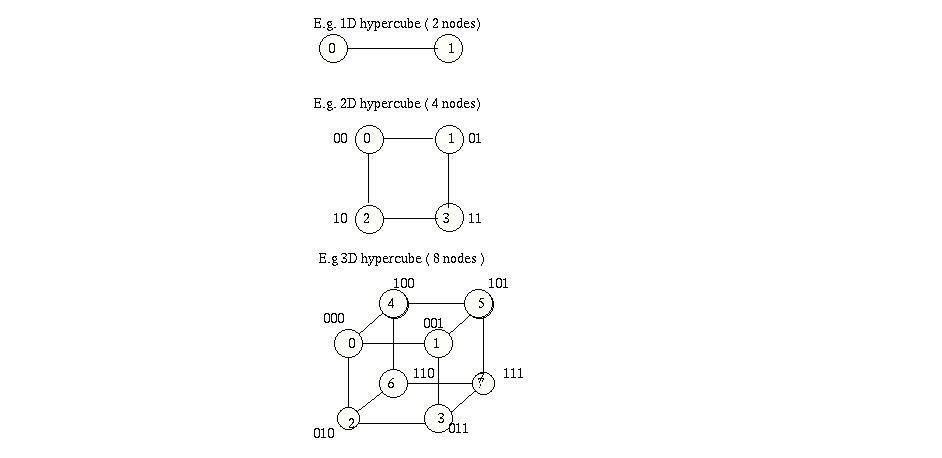
In addition, the regular and symmetric nature of the network provides fault tolerance. Most Important parameters of an interconnection network of a multicomputer system are its scalability and modularity. Scalable networks have the property that the size of the system (e.g., the number of nodes) can be increased with minor or no change in the existing configuration. Also, the increase in system size is expected to result in an increase in performance to the extent of the increase in size. a major drawback of the hypercube network is its lack of scalability, which limits its use in building large size systems out of small size systems with little changes in the configuration. As the dimension of the hypercube is increased by one, one more link needs to be added to every node in the network. Therefore, it becomes more difficult to design and fabricate the nodes of the hypercube because of the large fan-out.
Twisted Cubes
Twisted cubes are variants of hypercubes. The n-dimensional twisted cube has 2n nodes and n2n-1 edges. It possesses some desirable features for interconnection networks . Its diameter, wide diameter, and faulty diameter are about half of those of the n-dimensional hypercube. A complete binary tree can be embedded into it. The five-dimensional twisted cube TQ5, where the end nodes of a missing edge are marked with arrows labeled with the same letter is shown below
Extended Hypercube
The hypercube networks are not truly expandable because we have to change the hardware configuration of all the nodes whenever the number of nodes grows exponentially, as the nodes have to be provided with additional ports. an incompletely populated hypercube lacks some of the properties which make the hypercube attractive in the first place <ref name="ext-hypercube">J.Mohan Kumar; L.M.Patnaik; "Extended Hypercube: A Hierarchical Interconnection Network of Hypercubes" IEEE TRANSACTIONS ON PARALLEL AND DISTRIBUTED SYSTEMS, VOL. 3, NO. 1, JANUARY 1992 [2]</ref>. Complicated routing algorithms are necessary for the incomplete hypercube. Extended Hypercube(EH) retains the attractive features of the hypercube topology to a large extent. The EH is built using basic modules consisting of a k-cube of processor elements (PE’s) and a Network Controller (NC) as shown in the figure below. The NC is used as a communication processor to handle intermodule communication; 2k such basic modules can be interconnected via 2k NC’s, forming a k-cube among the NC’s. The EH is essentially a truly expansive, recursive structure with a constant predefined building block. The number of I/O ports for each PE (and NC) is fixed and is independent of the size of the network. The EH structure is found to be most suited for implementing a class of highly parallel algorithms. The EH can emulate the binary hypercube in implementing a large class of algorithms with insignificant degradation in performance. The utilization factor of the EH is higher than that of the Hypercube <ref name="Otis-Hypercube">Basel A. Mahafzah; Bashira A. Jaradat; "The load balancing problem in OTIS-Hypercube interconnection networks" The Journal of Supercomputing Volume 46 Issue 3, December 2008 [3]</ref>.
Balanced Hypercube
As the number of processors in a system increases, the probability of system failure can be expected to be quite high unless specific measures are taken to tolerate faults within the system. Therefore, a major goal in the design of such a system is fault tolerance. These systems are made fault-tolerant by providing redundant or spare processors and/or links. When an active processor (where tasks are running) fails, its tasks are dynamically transferred to spare components. The objective is to provide an efficient reconfiguration by keeping the recovery time small. It is highly desirable that the reconfiguration process is a decentralized and local one, so fault status exchange and task migration can be reduced or eliminated. The Balanced Hypercube is a variation of the Hypercube structure that can support consistently recoverable embedding. Balanced hypercubes belong to a special type of load balanced graphs [10] that can support consistently recoverable embedding. In a load balanced graph G = (V, E), with V as the node set and E as the edge set, for each node v there exists another node v’, such that v and v’ have the same adjacent nodes. Such a pair of nodes v and v’ is called a matching pair.
In a load balanced graph, a task can be scheduled to both v and v’ in such a way that one copy is active and the other one is passive. If node v fails, we can simply shift tasks of v to v’ by activating copies of these tasks in v’. All the other tasks running on other nodes do not need to be reassigned to keep the adjacency property, i.e., two tasks that are adjacent are still adjacent after a system reconfiguration. Note that the rule of v and v’ as primary and backup are relative. We can have an active task running on node v with its backup on node v’, while having another active task running on node v’ with its backup on node v. With a sufficient number of tasks and a suitable load balancing approach, we can have a balanced use of processors in the system.
A graph G is load balanced if and only if for every node in G there exists another node matching it, i.e., these two nodes have the same adjacent nodes. Hence they are called a matching pair. A completely connected graph with an even number of nodes is load balanced, while several other commonly used graph structures, such as meshes, trees, and hypercubes, are not. In the figures shown labeled as BHn, n is called the dimension of the balanced hypercube.
Balanced Varietal Hypercube
A n dimensional, balanced varietal hypercube consists of 2^2n nodes. Every node connects 2n nodes, which are of 2 types :a)Inner nodes b)Outer nodes through hyperlinks <ref name="ext-var">C. R. Tripathy; N. Adhikari; "ON A NEW MULTICOMPUTER INTERCONNECTION TOPOLOGY FOR MASSIVELY PARALLEL SYSTEMS" International Journal of Distributed and Parallel Systems (IJDPS) Vol.2, No.4, July 2011[4]</ref>
a) Inner node: Case I: When a0 is even:
(i) <(a0+1)mod 4, a1,a2..... an-1> (ii)< (a0-2)mod 4, a1,a2..... an-1>
Case II: When a0 is odd:
(i) <(a0-1)mod 4, a1,a2..... an-1> (ii)< (a0+2)mod 4 ,a1,a2..... an-1>
b) Outer node: Case I: When a0=0,3:
(i) For ‘ai’ = 0
<(a0+1) mod 4 , a1,....,(ai+1)mod 4 a2,....,an-1> <(a0-1) mod 4 , a1,....,(ai+1)mod 4 a2,....,an-1>
(ii) For ‘ai’ = 3
<(a0+1) mod 4 , a1,....,(ai-1)mod 4 ,....,an-1> <(a0-1) mod 4 , a1,....,(ai-1)mod 4 ,....,an-1>
Case II: when a0=1,2 and ai= 0,3:
<(a0+1) mod 4 , a1,....,(ai+2)mod 4 ,....,an-1> <(a0-1) mod 4 , a1,....,(ai+2)mod 4 ,....,an-1>
Case III: when a0=0,1
(i) For ai=1
<(a0+1) mod 4 , a1,....,(ai+2)mod 4 ,....,an-1> <(a0-1) mod 4 , a1,....,(ai-1)mod 4 ,....,an-1> (ii) For ai=2 <(a0+1) mod 4 , a1,....,(ai+2)mod 4 ,....,an-1> <(a0+1) mod 4 , a1,....,(ai+2)mod 4 ,....,an-1>
Case IV: when a0=2,3
(i) For ai=1 <(a0+1) mod 4 , a1,....,(ai-1)mod 4 ,....,an-1> <(a0-1) mod 4 , a1,....,(ai+2)mod 4 ,....,an-1>
(ii) For ai=2
<(a0+1) mod 4 , a1,....,(ai+1)mod 4 ,....,an-1> <(a0-1) mod 4 , a1,....,(ai+2)mod 4,....,an-1>
Properties of a Balanced Varietal Hypercube
The degree of any node in the Balanced varietal hypercube of dimension n is equal to 2n.
An n-dimensional Balanced varietal hypercube has n* 22n edges.
The diameter of an n-dimensional Balanced varietal hypercube is
i. 2n for n=1 ii. ceil(n+n/2) for n> 1.
The average distance conveys the actual performance of the network better in practice. The summation of distance of all nodes from a given node over the total number of nodes determines the average distance of the network. In the Balanced varietal hypercube the average distance is given by 1/(2^2n)∑[d(0,0,0),k]
Cost is an important factor as far as an interconnection network is concerned. The topology which possesses minimum cost is treated as the best candidate. Cost factor of a network is the product of degree and diameter. The cost of an n-dimensional balanced varietal hypercube is given by 2n* ceiling(n + n/2).
Routing in Balanced Varietal Hypercube
In routing process, each processor along the path considers itself as the source and forwards the message to a neighbouring node one step closer to the destination. The algorithm consists of a left to right scan of source and destination address. Let r be the right most differing bit (quarternary) position. The numbers to the right of ur is not to be considered as they lie on the same BVHr . Since the diameter of BVH1 is 2 there is atleast one vertex which is a common neighbour of ur and vr. If d is an element such that d neighbour of ur is also a neighbour of vr.Then d is choosen such that ur=vr. Then in the next step d1 is choosen such that ur-1=vr-1. This process continues until u=v.
Algorithm:Procedure Route(u,v)
{
r: right most differing bit position
d:choice such that dur=vr
route to d-neighbour else
route to r-neighbour (k and v are adjacent)
if (u and v are not adjacent) then
d1=choice that dur-1=dvr-1
route to d1 neighbour
}
Broadcast in Balanced Varietal Hypercube
Broadcasting refers to a method of transferring a message to all recipients simultaneously.The broadcast primitive finds wide application in the control of distributed systems and in parallel computing. An optimal one-to-all broadcast algorithm is presented for BVHn assuming that concurrent communication through all ports of each processor is possible. It consists of (n+1) steps as shown below.
Procedure Broadcast(u,n):
Step1: send message to 2n neighbours of u
Step 2: one of 2n nodes sends message to its 2n-1 neighbours. Then n nodes from the rest nodes
send message to their (2n-2) neighbours.
Step 3: continue step 2 till all the nodes get the message.
Step 4: end
Reliable Omega interconnected networks
The omega network topology supports both one-to-one routing and broadcast routing. Since every node in the system is a fixed size, the system can be easily scaled to larger systems. The omega network belongs to the multistage interconnection networks (MINs). Since the omega network is designed for larger systems, it depends heavily on reliability, therefore we will also discuss an enhanced version of the omega network <ref name="omega">Bataineh, Sameer; Qanzu'a, Ghassan.; , "Reliable Omega Interconnected Network for Large-Scale Multiprocessor Systems" The Compter Journal, 2003. vol. 46, no. 5, pp.467-475, 2003 [5]</ref>.
The original omega distributed-memory multiprocessor is of size...
- N=L x (log2(L) + 1)
- N = number of switches
- L = number of levels
- (log2(L) + 1) = number of stages
Each link between nodes is used bidirectionally to send data.
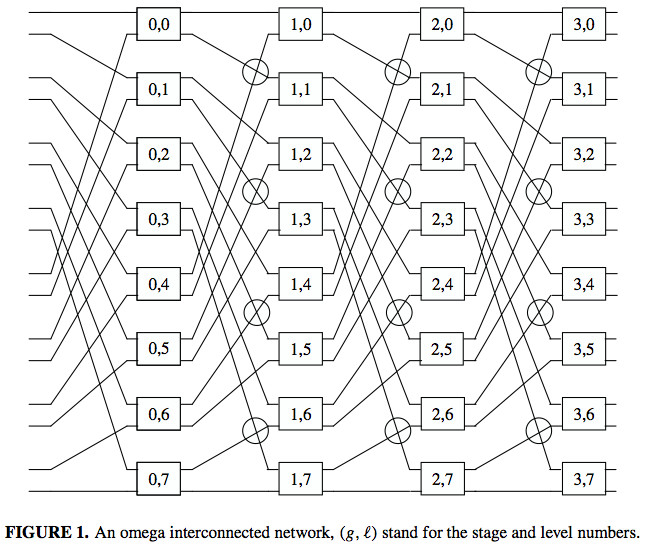
Figure 1 above has 32 nodes with 8 levels. Each node as four links connected it to the previous and next stages. The connections go as follows.
- Output link x on stage g connects to input link σn(x) on stage g+1
- 0 ≤ g < log2(L)
- x is an n+1 bit number if the form x = {bn,bn-1,...,b1,b0}
- σn(x) = {bn−1,...,b2,b1,b0,bn}
- In the Figure 1 above L=8, N=32, n=3, and x=0-15 and has a four bit representation
Proposed Reliable Omega Design
To create a more reliable design, it must ensure that the system maintains its structure after a fault. Therefore for the proposed design there are extra links between nodes and an extra stage the end to improve reliability. This way if a node faults it can be replaced.
The extra links are added as such...
The added links and nodes are represented in Figure 2 below.
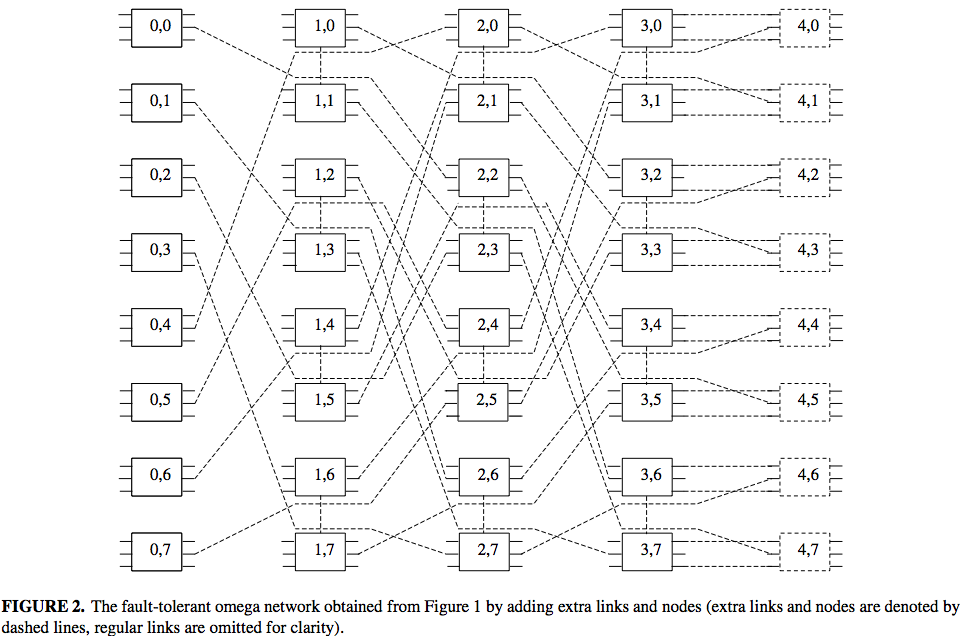
Node Replacement Policy and Reconfiguration
When a node fails in the system it must be reconfigured to replace it and maintain the omega topology.
Replacement
If a spare node fails then it does not requeire replacement and can easily be bypassed. However if and active node fails, then it must be replaced by its dual node. The dual node is replaced by it dual node until a spare node replaces the original active node.
The dual of a node is determined by...
- (g,l) has a dual node at (g+1, 2 ( l%L/2) + bn), where g ≤ n − 1
- ... or (n,l) has a dual node at (n + 1, l) if that is a spare node to the right in the same level
Reconfiguration
A node path can suffer one fail then all other nodes perform the Replacement procedure. However, if another node fails then all nodes after that participate in the Reconfiguration procedure.
The reconfiguration procedure is as follows...
- The failed node is bypassed
- The node (k,l) in the node path carries out the following steps.
Reliability Analysis
Figure 7 and Figure 8 above graph the reliability [R(t)] of the Omega, Fault-tollerant Butterfly, and fault-tolerant omega topologies over time. This shows that the fault-tolerant omega demonstrates more reliability over time than the original omega design, even with added complexity.
K-Ary n-cube Interconnection networks
The purpose of this section is to demonstrate how the outdated k-ary n-cube interconnection networks were never really used for large scale multiprocessor systems.<ref name="k-ary">Dally, William J.; , Performance Analysis of k-ary n-cube Interconnection Networks" IEEE Transactions on Computers. vol. 39, no. 6, pp.775-785, June 1990 [6]</ref> VLSI systems, a.k.a k-ary n-cube, are communication limited rather than processing limited. This means that is performance is dependent on the wire used to connect the system. This section will show through latency, throughput, hot-spot throughput that k-ary n-cube interconnection networks work better on lower-dimensional networks than it does on high-dimensional networks, assuming constant bisectional width.
VLSI Complexity
Since VLSI systems are wire-limited, meaning that the speed that it can run at is dependent on the wire delay. This means that systems are required to organize there nodes logically and physically to keep the wires as short as possible. Networks that work with higher dimensions cost more dut to the fact that there are more and longer wires, compared to low-dimension networks.
Latency
Latency is a measure of network performance, where it is the sum of the latency due to the network and the latency due to the processing node. Figure 8 below shows the average network latency vs dimension with varying nodes. Figure 8 demonstrates that low-dimensional networks provide lower latency than high-dimensional networks with a constant delay.

The low-dimensional networks are able to capitalize on locality and have lower latency. However, the high-dimensional networks are do not benefit from locality and are forced to have longer message lengths.
Figure 9 and 10 further demonstrate how latency increases with higher dimensional networks, using logarithmic and linear delay. With linear delay, latency is determined solely by bandwidth and physical distance, putting the higher dimensional networks at a disadvantage.
Throughput
Throughput is another metric of network performance. Throughput is the total number of messages the network can handle per unit of time. This can best be estimated by calculating the total capacity of the given network. Low-dimensional networks's latency increase slower when the traffic is actually applied vs high-dimensional networks. The low-dimensional networks are able to handle contention better because they use fewer channels at higher bandwidth and get better throughput performance than the high-dimensional networks.
Figure 14 above shows how latency increases as there is more traffic applied to the different k-ary n-cube systems.
Hot-Spot Throughput
Hot spot throughput describes the situation where traffic is not uniform, instead it is concentrated in a pair of nodes that is responsible for higher traffic. Hot-spot traffic causes congestion and can hurt the throughput. As with normal throughput, low-dimensional networks have better bandwidth and thus better hot-spot throughput than the high-dimensional networks.
Conclusion
Low-dimensional k-ary n-cube networks have lower latency, less contention, and higher hot-spot throughput than the high-dimensional networks. This demonstrates how this outdated network technique is not suitable for larger machines, cause is does not scale well.
Glossary
- Latency - network measurement of time delay
- Throughput - network measurement of the total number of messages the network can handle at a time
- Hot-Spot Throughput - describes the situation where traffic is not uniform and certain nodes are responsible for higher traffic.
Quiz
Question 1 : Two nodes in the hypercube are adjacent if and only if they differ at how many bit positions
a) Two b) One c) Three d) Zero
Question 2 : A n dimensional, balanced varietal hypercube consists of how many nodes?
a) 2n b) 2n-1 c) 2^2n d) 2^2n -1
Question 3 :The maximum number of links that must be traversed to send a message to any node is the
a) Network Narrowness b) Network Increments c) Network Diameter d) Network Connectivity
Question 4 :It is difficult to design and fabricate the nodes of the hypercube because
a) Large fan out b) Increased Heat Dissipation c) Lesser number of neighbours d) Small Diameter
Question 5 : A good reason for choosing Balanced Hypercube is
a) Large Diameter b) Fault Tolerance c) Increased Heat Dissipation d) Average Distance
Question 6 : What does the omega network support?
a) one-to-one routing b) broadcast routing c) both a) and b) d) none of the above
Question 7 : The original omega network node consists of how many links?
a) 2 b) 4 c) 6 d) 8
Question 8 : How does the replacement policy work in the omega network?
a) Arbitrarily finds a spare node to replace b) Dual nodes are replace by dual nodes until a spare node is found c) The node is replaced by its dual node d) Both b) and c)
Question 9 : How is NOT true about k-ary n-cube (VLSI) systems?
a) better in high-dimension networks b) organized nodes logically and physically to keep wires shorter c) better in low-dimension networks d) physically limited by wire size
Question 10 : What is NOT a measurement tool used to compare k-ary n-cube systems?
a) Latency b) Miss rate c) Hot-Spot Throughput d) Throughput
Solutions : 1-b 2-c 3-c 4-a 5-b 6-c 7-b 8-d 9-a 10-b
References
<references />


